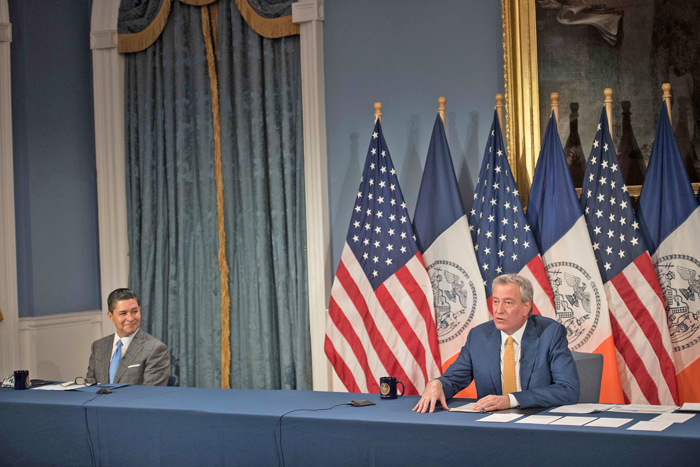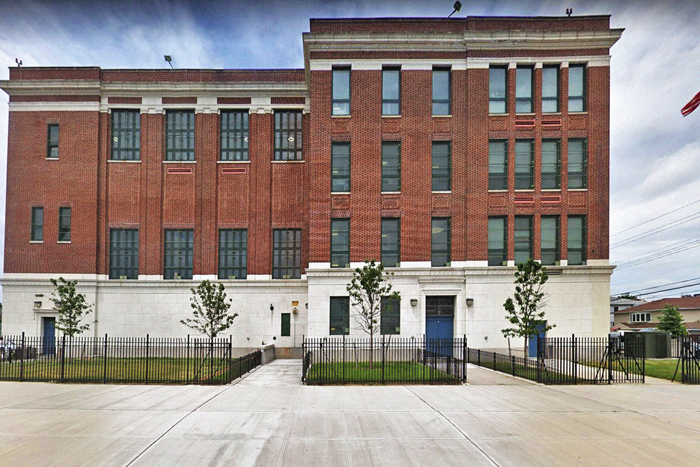Photo Courtesy of Michael Appleton/Mayoral Photography Office
Mayor Bill de Blasio and Schools Chancellor Carranza recently detailed school reopening plans for fall 2020.
By Michael V. Cusenza
City school reopening plans will cover four main areas: health and safety, building programming and scheduling, blended learning, and family engagement, and all students will have an option to be all-remote in the fall, Mayor Bill de Blasio and Schools Chancellor Richard Carranza recently announced.
According to the administration, schools will be provided with specific models to develop schedules for students that include in-person and remote instruction every week. Personalized schedules will be shared with families in August, and the Department of Education will continue to update families so they can plan for a successful return to school buildings.
According to de Blasio and Carranza, school buildings will promote healthy behaviors and environments by requiring physical distancing, face coverings, and increasing access to hand washing and sanitizer. Physical spaces will be configured to ensure appropriate distances, lunch will be held in classrooms or require assigned seating, and each campus will have an identified Isolation Room in the event someone becomes ill.
Each building will be deep cleaned on a nightly basis with electrostatic sprayers which dispense disinfectant so that it adheres to surfaces without the need to physically touch them, and will have improved HVACs for ventilation. Every classroom will have hand sanitizer and disinfectant.
Using guidelines from the Center for Disease Control and Prevention, New York State Department of Health, and New York City Department of Health and Mental Hygiene; data from the Principal Annual Space Survey; enrollment data; and capacity and utilization data, schools are calculating their maximum capacity taking social distancing into account. These calculations account for at least six feet of space around each person in a classroom while ensuring that there remains room for teachers and students to circulate.
The DOE has developed three baseline scheduling models for all schools to use. The models have been created in close collaboration with principals and developed by analyzing system-wide constraints, researching national and international best practices, and surveying families and students. They are meant to support schools in determining how to serve the needs of their students and families in maximizing in-person attendance in line with health and safety guidance, while also providing as much consistency as possible for families. Separately, the DOE is also providing two additional models for schools serving students with disabilities, known as District 75 schools, that meet their unique programming and student needs.
All families will also have an option to pursue an all-remote schedule next fall. The DOE will be sending additional information in the coming weeks on how families can voluntarily select this option. Students will not need a medical reason to register for this option. Families who opt for fully-remote learning will be able to review this decision at specified intervals during the school year, and may opt back into in-person learning if they would like to do so. Additional details on these processes will be announced in the coming weeks.
Model One: Taking into account student population and the space available in the building, for schools able to accommodate at least 50 percent of their student population with physical distancing, students will receive in-person instruction for the same two days every week, as well as every other Monday. This amounts to a total of five days of in-person instruction every two weeks. In this model, there are two in-person student groups and one fully remote student group. Students will participate in remote learning for non-in-person days. This model is available to elementary, middle, and high schools.
Model Two: Taking into account student population and the space available in the building, for schools able to accommodate roughly one-third of their student population, students will receive in-person instruction 1-2 days per week. This amounts to a total of five days in-person every three weeks. To maximize consistency, one day will be the same each week. Students will participate in remote learning for non-in-person days. For schools able to accommodate roughly one-third of their student population with physical distancing, this model is the Chancellor’s preference because it provides one consistent day each week. This model is available to elementary, middle, and high schools.
Model Three: This model serves the same number of students as Model Two, also providing five days in-person every three weeks but with a different cadence and schedule. Model Three offers an option for a six-day rotation, allowing students to be in-person two days and remote four days in a six-day cycle. This model is available to middle and high schools.
De Blasio and Carranza noted that, with all models, students will be learning five days a week. Blended learning is designed to create seamless transitions in and out of a remote setting, and all curriculum will be adaptable in both learning environments. Schools will emphasize academic continuity for students, and provide additional support on the days students are learning remotely.
The administration noted that as the DOE has adapted practices, the agency has invested in the technology required to provide a quality online academic experience—distributing over 300,000 iPads to students who need them—and the agency has indicated that it is working with teachers to be more effective online instructors. At the same time, DOE is working on policies and guidelines to update curriculum to reflect the blended learning online and in-person model, as well as the appropriate social-emotional learning and mental health supports.
Teachers, staff, and students will have the time and support they need to adapt to these necessary changes. Social-emotional learning and trauma-informed care will be integrated throughout the year, and all schools will offer mental health support. The City will also continue to offer in-person services to students with disabilities to the greatest extent possible, and provide instruction for multilingual learners in-person and remote in a student’s home language where needed.
“Getting our kids back to school successfully and safely is the single biggest part of restarting our city,” Hizzoner added. “Parents have spoken clearly—they want their children back in school buildings to the greatest extent possible. Our approach for the fall maximizes in person instruction while protecting health and safety of our students and educators.”


